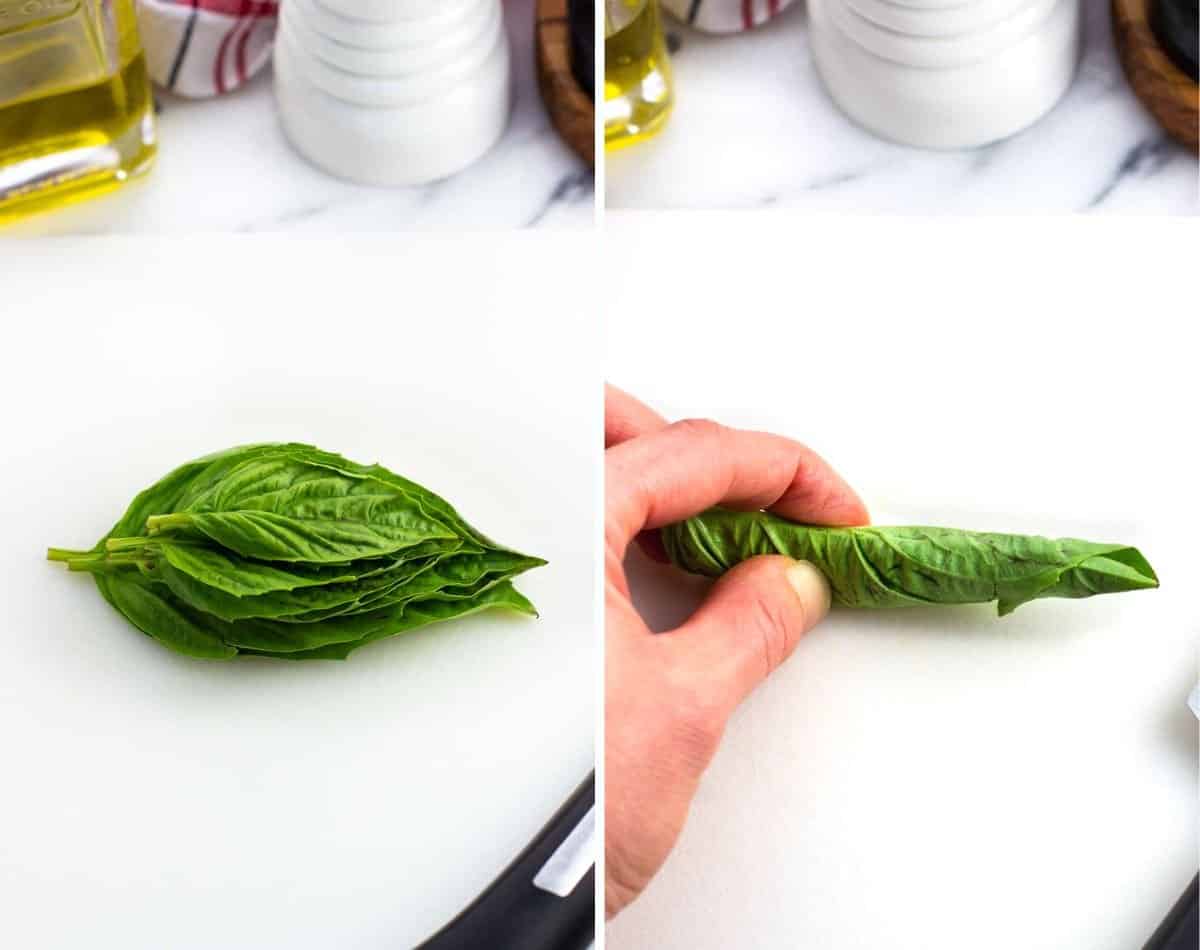Learning how to chiffonade basil is a game-changer when it comes to garnishing pasta, salads, and entrees with fresh basil. This easy technique can also be applied to other flat-leafed herbs and greens like mint, spinach, and more.

Even though I consider fresh basil to be one of the very best aromas and flavors in the world, I think it's a real possibility to overdo it when garnishing.
Have you ever taken a bite of something that had too much fresh basil on it? Like a big hunk of a leaf? It's pretty pungent!
That's where chiffonading basil comes in. While it sounds fancier than it is, this French culinary term refers to the efficient process of slicing a stack of broad-leafed herbs and greens into thin strips.
These smaller ribbons are the perfect size for evenly scattering over a dish before serving, all without the worry of chopping uneven, too-large pieces.

What You'll Need
- Cutting board: Your favorite will do the trick, whether it be plastic or wood. I don't recommend glass cutting boards as the super hard surface can more easily dull and damage your knives.
- Sharp knife: You don't need a specialty knife, such as a curved mezzaluna, to chiffonade basil. The big requirement is that it's not dull as to not crush the edges and cause them to turn an unappealing black color. While the ability to rock the knife blade back and forth is helpful (like on a chef's knife blade) this isn't a lengthy slicing process so I also use a Santoku knife if that's the one I have available.
- Basil: Whole fresh basil leaves are used to chiffonade. The leaves don't need to be all the same size, as smaller leaves will be wrapped up and held in place in the rolling step shown below.
Step-by-Step Instruction
- Stack basil leaves on top of one another, with the largest ones on the bottom and smallest ones on top. This helps the stack hold together better in the next step.
- Starting with one of the long sides, tightly roll the basil leaves into a tube.

- With one hand holding the tube of basil firmly, carefully slice thin strips, starting from one end of the tube.

- Unfurl the swirls of basil to separate out the strips individually. Use these ribbons to provide a fragrant pop of bright green herb-y flavor to a wide variety of dishes.

Frequently Asked Questions
Any herb that has leaves with a flat, wide surface area can be cut in the chiffonade style, including basil, mint, and sage. Leafy greens like spinach, kale, collard greens, and chard can also be cut chiffonade.
Basil chiffonade can be used to garnish pizzas, panini, soups (such as Italian sausage soup), salads (kale caprese salad), pastas (chicken parmesan gnocchi skillet), and chicken entrees (baked chicken parmesan).
More How-Tos
If you’ve enjoyed this recipe, I’d love for you to leave a star rating in the recipe card and/or a comment review below!

How to Chiffonade Basil
Equipment
- Cutting board
- Sharp knife
Ingredients
- Fresh basil leaves
Instructions
- Rinse basil leaves under cool water and pat dry.
- Stack the basil leaves on top of one another. Arrange them so that the largest leaf is on the bottom of the stack and the smallest leaf is on the top, with the leaves gradually getting smaller as the stack rises.
- From one of the long sides of the stack, tightly roll up the basil leaves into a snug tube.
- Holding the tube of basil together with your non-dominant hand, slice the tube perpendicularly into thin strips. Once the tube is fully sliced, use your hands to separate out the swirls into individual strips for garnishing.
- If you'd like even smaller pieces, given the pile a brief, rough chop.
Nutritional information is provided as an estimate. As it can vary due to many factors (brands used, quantities, etc.), we cannot guarantee its accuracy.
Food Safety and Nutrition DisclaimerWould you like to save this?
Plus receive periodic recipe newsletter emails.






Comments
No Comments